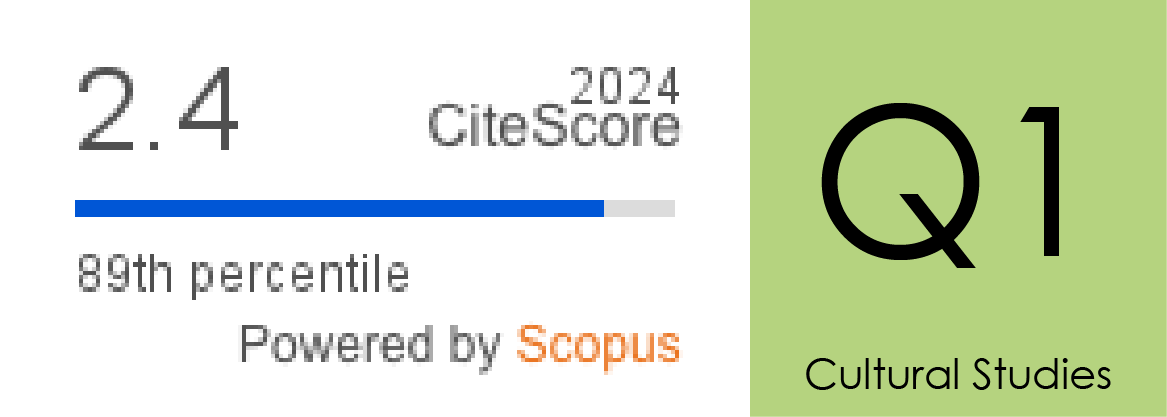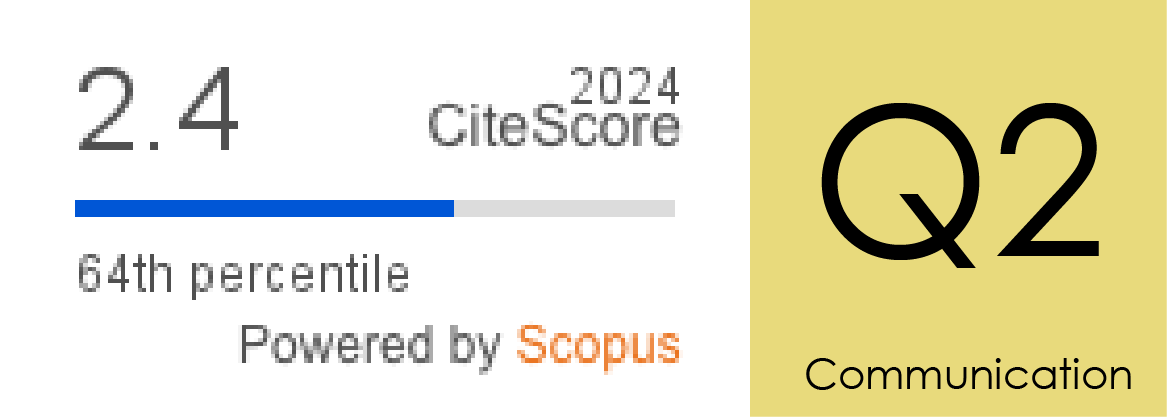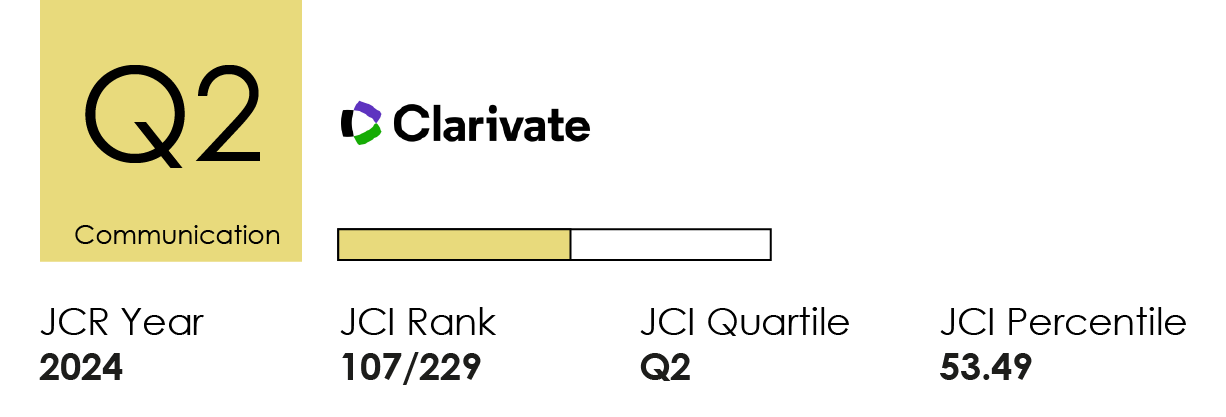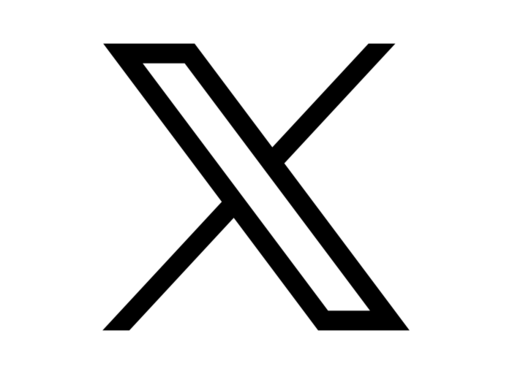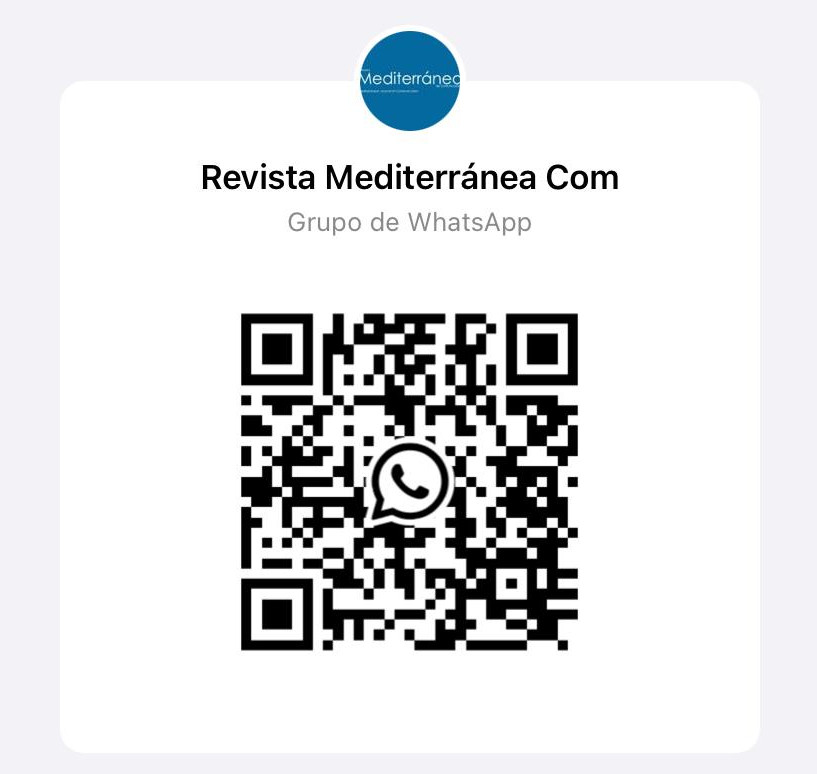Fotoprotección y percepción del riesgo. Creencias y factores que influyen en los comportamientos preventivos entre jóvenes universitarios desde el Health Belief Model
DOI:
https://doi.org/10.14198/MEDCOM.29088Palabras clave:
comunicación de salud, health belief model, salud pública, cáncer de piel, campañas de comunicación estrat´égicaResumen
Propósito. Este estudio analiza los factores que influyen en la adopción de comportamientos de fotoprotección e identifica áreas clave de intervención. Los resultados contribuirán al diseño de estrategias efectivas en campañas de prevención del cáncer de piel, especialmente dirigidas a la juventud universitaria en España, un grupo de alto riesgo. Metodología. La investigación, enmarcada en el proyecto I+D+i PID2020-116487RB-100, empleó grupos de discusión con estudiantes universitarios para examinar sus creencias sobre el cáncer de piel según el Health Belief Model (HBM). Los datos, obtenidos mediante grabaciones y transcripciones, fueron analizados a través de codificación abierta y análisis temático, identificando patrones clave sobre percepciones y comportamientos preventivos. Resultados y conclusiones. Los hallazgos indican que los estudiantes universitarios españoles tienen cierto conocimiento sobre la fotoprotección y los riesgos del cáncer de piel. Sin embargo, una baja percepción de susceptibilidad, la presencia de múltiples barreras y una reducida autoeficacia impiden que esta conciencia se traduzca en conductas preventivas constantes. Aportación novedosa. Este estudio es pionero en España al profundizar en la formación de creencias de la juventud y en su experiencia directa sobre la fotoprotección. Aporta una nueva perspectiva cualitativa que permite comprender mejor la desconexión entre conocimientos, creencias y comportamientos preventivos.
Financiación
Ministerio de Ciencia e Innovación de España (MCIN), Agencia Estatal de Investigaci´ón (AEI)Citas
Armstrong, B. K., & Cust, A. E. (2017). Sun exposure and skin cancer, and the puzzle of cutaneous melanoma: a perspective on Fears et al. Mathematical models of age and ultraviolet effects on the incidence of skin cancer among whites in the United States. American Journal of Epidemiology, 1977(105), 420–427. https://doi.org.0.1016/j.canep.2017.04.004
Asociación Española Contra el Cáncer [AECC] (2024). Cáncer de piel. https://bitly.cx/ipa6H
Backes, C., Religi, A., Moccozet, L., Behar-Cohen, F., Vuilleumier, L., Bulliard, J. L., & Vernez, D. (2019). Sun exposure to the eyes: predicted UV protection effectiveness of various sunglasses. Journal of exposure science & environmental epidemiology, 29(6), 753–764. https://doi.org/10.1038/s41370-018-0087-0
Backes, C., Religi, A., Moccozet, L., Vuilleumier, L., Vernez, D., & Bulliard, J. L. (2018). Facial exposure to ultraviolet radiation: Predicted sun protection effectiveness of various hat styles. Photodermatology, photoimmunology & photomedicine, 34(5), 330–337. https://doi.org/10.1111/phpp.12388
Bruce, A. F., Theeke, L. & Mallow J. (2017). A state of the science on influential factors related to sun protective behaviors to prevent skin cancer in adults. Int J Nurs Sci., 4(3), 225–235. https://doi.org/10.1016/j.ijnss.2017.05.005
Buchanan, N., Berktoldb, J., Holman, A. M., Stein, K., Prempeh, A., & Yerkesc, A. (2018). Skin cancer knowledge, awareness, beliefs and preventive behaviors among black and hispanic men and women. Preventive Medicine Reports, 12, 203–209. https://doi.org/10.1016/j.pmedr.2018.09.017
Cambil-Martín, J., Sánchez López, J. D., Rodríguez-Martínez, A., Rivas-Ruiz, F., Salazar-Granizo, Y. E., Herrera-Molina, A. S., Blázquez-Sánchez, N. y de Troya-Martín, M. (2023). Sun exposure practices, attitudes and knowledge among students and teachers at a University School of Health Sciences in Ecuador. Preventive Medicine Reports, 36, 102458. https://doi.org/10.1016/j.pmedr.2023.102458
Carrero, V., Soriano-Miras, R. y Trinidad, A. (2012). Teoría Fundamentada ‘Grounded Theory’. El desarrollo de teoría desde la generalización conceptual, Cuadernos. Centro de Investigaciones Sociológicas, Madrid.
Carril-Zerpa, A., Jacott-Jiménez, L., y Fuentes-Lara, C. (2024). Utopías migrantes y movilidad laboral en la Comunidad de Madrid: trayectorias, actos de resistencia y perspectivas de futuro. RIEM. Revista Internacional De Estudios Migratorios, 14(1), 1–30. https://doi.org/10.25115/riem.v14i1.10228
Cayuela, L., y Cayuela, A. (2023). La creciente amenaza del melanoma en España: un análisis exhaustivo de 30 años (1990-2019). Cánceres, 16(6), 1167. https://doi.org/10.3390/cancers16061167
Çelik, B. A., & Koç, V. (2023). Skin Cancer-Related Health Behavior Interventions in the Context of the Health Belief Model. Psikiyatride Guncel Yaklasimlar - Current Approaches in Psychiatry, 15(1), 83–102. https://doi.org/10.18863/pgy.1112210
Cercato, M. C., Ramazzotti, V., Sperduti, I., Ribes, I., & Nagore, E. (2015). Sun Protection Among Spanish Beachgoers: Knowledge, Attitude and Behaviour. Journal of Cancer Education, 30(4), 4–11. https://doi.org/10.1007/s13187-014-0671-5
Champion, V. L., & Skinner, C. S. (2008). The health belief model. In K. Glanz, B. K. Rimer, & K. Viswanath (Eds.), Health behavior and health education: Theory, research, and practice (pp.asibase 45–65). Jossey-Bass.
Cisneros-Caicedo, A. J., Guevara-García, A. F., Urdánigo-Cedeño, J. J. y Garcés-Bravo, J. E. (2022). Técnicas e Instrumentos para la Recolección de Datos que apoyan a la Investigación Científica en tiempo de Pandemia. Dominio de las ciencias, 8(1), 1165–1185. http://dx.doi.org/10.23857/dc.v8i41.2546
Comunicancer (2025). Redes sociales. https://bitly.cx/gdOhG
Dallazem, L. N. D., Benvegnú, A. M., Stramari, J. M., Beber, A. A. C., Chemello, R. M. L. & Beck, M. O. (2019). Knowledge and habits of sun exposure in university students: A cross-sectional study in Southern Brazil. An. Bras. Dermatol, 94, 172–18. https://doi.org/10.1590/abd1806-4841.20197507
Davati, A., Pirasteh, A., Yahyaei, M., & Shakouri, A. (2013). Skin protective behavior amongst girl students: Based on health belief model. Acta Medica Iranica, 51(9), 626–632. PMID: 24338194. https://bitly.cx/M8AH
Davis, R., Loescher, L. J., Rogers, J., Spartonos, D., Snyder, A., Koch, S., & Harris, R. B. (2015). Evaluation of Project Students are Sun Safe (SASS): A University Student-Delivered Skin Cancer Prevention Program for Schools. Journal of Cancer Education, 30(4), 736–742. https://doi.org/10.1007/s13187-014-0742-7
de la Garza, H., Maymone, M.B.C., & Vashi, N.A. (2021). Impact of social media on skin cancer prevention. International Journal of Environmental Research and Public Health, 18(9), 5002. https://doi.org/10.3390/ijerph18095002
de Castro-Maqueda, G., Gutiérrez-Manzanedo, J. V., González-Montesinos, J. L., Pardal, C. V., Rivas-Ruiz, F. & de Troya-Martín, M. (2022). Sun Exposure and Photoprotection: Habits, Knowledge and Attitudes Among Elite Kitesurfers. J CancEduc, 37, 517–523. https://doi.org/10.1007/s13187-020-01838-7
Dehbari, S. R., Dehdari, T., Dehdari, L., & Mahmoudi, M. (2015). Predictors of Sun-Protective Practices among Iranian Female College Students: Application of Protection Motivation Theory. Asian Pacific Journal of Cancer Prevention, 16(15), 6477–6480. https://doi.org/10.7314/apjcp.2015.16.15.6477
Denzin, N. (2017). Critical Qualitative Inquiry. Qualitative Inquiry, 23(1), 8–16. https://doi.org/10.1177/1077800416681864
Dillard, A. J., Ferrer, R. A., & Welch, J. D. (2018). Associations between narrative transportation, risk perception and behaviour intentions following narrative messages about skin cancer. Psychology & Health, 33(5), 573–593. https://doi.org/10.1080/08870446.2017.1380811
Doyon, V., Liu, C. & Bailey, K. (2022). When tanning is trending: A content quality study of skin cancer on TikTok. American Academy of Dermatology Association, 87(3), AB220. https://doi.org/10.1016/j.jaad.2022.06.910
Fernández-Morano, T., De Troya-Martín, M., Rivas-Ruiz, F., y Buendía-Eisman, A. (2016). Hábitos de exposición solar, prácticas de fotoprotección, conocimientos y actitudes de los adolescentes andaluces. Actualidad Médica, 101(797), 33–37. https://doi.org/10.15568/am.2016.797.re01
Fuentes-Lara, C., Zeler, I., Moreno, Á. & de Troya-Martín, M. (2024). Sun behavior: exploring the health belief model on skin cancer prevention in Spain. J Public Health (Berl.). https://doi.org/10.1007/s10389-024-02335-7
Fuentes Lara, C. (2019). La situación de las mujeres porteadoras en la frontera sudeuropea: el caso de Ceuta. Madrid: CIS.
Gambla, W. C., Fernandez, A. M., Gassman, N. R., Tan, M. C. B. & Daniel, C. L. (2017). College tanning behaviors, attitudes, beliefs, and intentions: A systematic review of the literature. Preventive Medicine, 105, 77–87. https://doi.org/10.1016/j.ypmed.2017.08.029
Glaser, B. (1978). Theoretical Sensitivity: Advances in the methodology of grounded theory, Sociology Press, Mill Valley.
Hagerman, C. J., Stock, M. L., Jobe, M. C., Dwyer, L. A., Houlihan, A. E. & Yeung, E. W. (2024). Ethnic and Gender Differences in Sun-Related Cognitions Among College Students: Implications for Intervention. International Journal of Behavioral Medicine. https://doi.org/10.1007/s12529-024-10257-7
International Agency for Research on Cancer [IARC]. (2022). Skin cancer. https://bitly.cx/KWVJ
Jeihooni, A.K. & Rakhshani, T. (2019). The effect of educational intervention based on health belief model and social support on promoting skin cancer preventive behaviors in a sample of Iranian farmers. Journal of Cancer Education, 34, 392–401. https://doi.org/10.1007/s13187-017-1317-1
Jiménez-Sánchez, L., Moreno, Á. y Fuentes-Lara, M. C. (2025). Redes sociales e influencia en la salud de los jóvenes: Un estudio sobre las actitudes de bronceado y fotoprotección en España. Palabra Clave, 28(Suplemento1), e28s11x. https://doi.org/10.5294/pacla.2025.28.s1.1x
Jiménez-Sánchez, L., Moreno, Á., & Fuentes-Lara, M. C. (2024). Sun Exposure and Skin Cancer: An Examination of Communications for Prevention on Instagram in a High-Risk Context. Profesional de la información, 33(3), e330307. https://doi.org/10.3145/epi.2024.0307
Jiménez-Sánchez, L. y Moreno, Á. (2023). Comunicación para prevenir el cáncer de piel: un análisis del uso estratégico de la red social Twitter en España. Revista de Ciencias de la Comunicación e Información, 28, 190–205. https://doi.org/10.35742/rcci.2023.28.e289
Julian, A., Thorburn, S., & Geldhof, G. J. (2020). Health beliefs about UV and skin cancer risk behaviors. Cancer Control: Journal of the Moffitt Cancer Center, 27(4), 1–6. https://doi.org/10.1177/1073274819894008
Kitzinger J. (1995). Qualitative research. Introducing focus groups. BMJ, 311(7000), 299–302. https://doi.org.10.1136/bmj.311.7000.299
Kouhpayeh, A., Jeihooni, A. K., Kashfi, S. H., & Bahmandoost, M. (2017). Effect of an educational intervention based on the model of health beliefs in self-medication of Iranian mothers. Investigación y Educación en Enfermería, 35(1), 59–68. https://doi.org/10.17533/udea.iee.v35n1a07
Lapadat, J.C., Black, N.E., Clark, P.G., Gremm, R.M., Karanja, L.W., Mieke, L.W. & Quinlan, L. (2010). Life challenge memory work: using collaborative autobiography to understand ourselves. International Journal of Qualitative Methods, 9(1), 77–104. https://doi.org.10.1177/160940691000900108
Lim, M., Molenaar, A., Brennan, L., Reid, M. & McCaffrey, T. (2022). Young Adults’ Use of Different Social Media Platforms for Health Information: Insights From Web-Based Conversations. J Med Internet Res, 24(1), e23656. https://doi.org/10.2196/23656
Lim, T. L. C. (2020). Parental roles and childhood sun safety. Our Dermatology Online, 11(2), 186–188. https://doi.org/10.7241/ourd.20202.20
Luquis, R. R., & Kensinger, W. S. (2019). Applying the health belief model to assess prevention services among young adults. International Journal of Health Promotion and Education, 57(1), 37–47. https://doi.org/10.1080/14635240.2018.1549958
McDaid, O. & Melby, V. (2022). Female university students’ knowledge, attitudes, and behaviours towards sun exposure and the use of artificial tanning devices: the essence of reducing risky behaviours. J Public Health (Berl.) 30, 639–647. https://doi.org/10.1007/s10389-020-01335-7
McKenzie, C., Rademaker, A. W. & Kundu, R. V. (2018). Masculine norms and sunscreen use among adult men in the United States: A cross-sectional study. J Am Acad Dermatol, 81(1), 1–2. https://doi.org/10.1016/j.jaad.2018.11.053
Merten, J., King, J., & Dedrick, A. (2022). Content analysis of skin cancer screenings on Pinterest: An exploratory study. International Journal of Environmental Research and Public Health, 19(5), 2507. https://doi.org/10.3390/ijerph19052507
Mheidly, N. & Fares, J. (2020) Leveraging media and health communication strategies to overcome the COVID-19 infodemic. J Public Health Policy, 41(4), 410–420. https://doi.org/10.1057/s41271-020-00247-w
Miller, D.T., Baccam, Z. & Harris, R. B. (2022). Association of sun safety behaviors and barriers with sunburn history in college students in a region with high UV exposure. Curr. Oncol., 29, 9671–9680. https://doi.org/10.3390/curroncol29120759
Moradhaseli, S., Ataei, P., Farhadian, H., & Ghofranipour, F. (2019). Farmers’ preventive behavior analysis against sunlight using the health belief model: A study from Iran. Journal of Agromedicine, 24(1), 110–118. https://doi.org/10.1080/1059924X.2018.1541036
Niemeyer, T. D. (2004). Construccionismo social: aplicación del grupo de discusión en praxis de equipo reflexivo en la investigación científica. Revista de psicología, 13(1), 9–20. https://doi.org/10.5354/0719-0581.2004.17459
Pearlman, R. L., Patel, V., Davis, R. E., Ferris, T. S., Gruszynski, K., Elledge, T., Bhattacharya, K., & Nahar, V. K. (2021). Effects of health beliefs, social support, and self-efficacy on sun protection behaviors among medical students: testing of an extended health belief model. Archives of Dermatological Research, 313(6), 445–452. https://doi.org/10.1007/s00403-020-02123-9
Polic, M. & Holy, M. (2021), Gender-biased office culture in Croatian PR industry: why femininesectors practice masculine patterns? Corporate Communications, 26(4), 716–727. https://doi.org/10.1108/CCIJ-04-2021-0042
Ponce, S., Jódar, A., Borrego, L., y Saavedra, P. (2019). Comportamientos, actitudes y conocimientos relacionados con la exposición solar en estudiantes de medicina de la Universidad de Las Palmas de Gran Canaria. Actas Dermo-Sifiliográficas, 110(5), 372–384. https://doi.org/10.1016/j.ad.2018.10.002
Porto Pedrosa, L., y Ruiz San Román, J.A. (2014). Los grupos de discusión. En K. Sáenz López, & G. Támez González, Métodos y técnicas cualitativas y cuantitativas (pp. 253-273). México D.F., México: Tirant Humanidades.
Prado, G., Ederle, A. E., Shahriari, S. R., Svoboda, R. M., Farberg, A. S., & Rigel, D. S. (2019). Online sunscreen purchases: Impact of product characteristics and marketing claims. Photodermatology, Photoimmunology & Photomedicine, 35(5), 339–343. https://doi.org/10.1111/phpp.12480
Robles, B. (2011). La entrevista en profundidad: una técnica útil dentro del campo antropofísico, Cuicuilco, 18 (52), 39-49. https://bitly.cx/9H5y6
Rodríguez-Martínez, A., Vaz-Pardal, C., Aguilera-Arjona, J., Rivas-Ruiz, F., Doncel-Molinero, D., Ruiz-Paulano, M. Subert, A., Gutiérrez-Manzanedo, J. V., Cambil-Martín, J., de Gálvez-Aranda, M. V., Jiménez-López, L., Blázquez-Sánchez & de Troya-Martín, M. (2024). Skin cancer prevention in extreme sports: Intervention in a 24-h race. Photodermatology, Photoimmunology & Photomedicine, 40(1), e12940. https://doi.org/10.1111/phpp.12940
Rosenstock, I. M., Strecher, V. J., & Becker, M. H. (1988). Social learning theory and the health belief model. Health Education and Behavior, 15(2), 175–83. https://doi.org/10.1177/109019818801500203
Savoye, I., Olsen, C. M., Whiteman, D. C., Bijon, A., Wald, L., Dartois, L., Clavel-Chapelon, F., Boutron-Ruault, M. C. y Kvaskoff, M. (2018). Patterns of ultraviolet radiation exposure and skin cancer risk: the E3N-SunExp Study. J Epidemiol, 28(1), 27–33. https://doi.org/10.2188/jea.JE20160166
Sharifikia, I., Rohani, C., Estebsari, F., Matbouei, M., Salmani, F. & Hossein-Nejad, A. (2019). Health belief model-based intervention on women's knowledge and perceived beliefs about warning signs of cancer. Asia–Pacific Journal of Oncology Nursing, 6(4), 431–439. https://doi.org/10.4103/apjon.apjon_32_19
Sirera-Rus, M. P., Ipiens-Serrate, J. R., Ferrer-Gracia, E., Teruel-Melero, P., Gállego-Diéguez, J. y Gilaberte, Y. (2020). Efectividad del programa SolSano en los hábitos, conocimientos y actitudes en materia de fotoprotección de los universitarios. Actas Dermosifiliogr, 111, 381–89, https://doi.org/10.1016/j.ad.2019.08.002
Sociedad Española de Oncología Médica [SEOM]. (2022). Melanoma. https://bitly.cx/JoSHH
Støle, H. S., Nilsen, L. T. N., & Joranger, P. (2019). Beliefs, attitudes and perceptions to sun-tanning behaviour in the norwegian population: A cross-sectional study using the health belief model. BMC Public Health, 19(206), 1–12. https://doi.org/10.1186/s12889-019-6503-0
Tizek, L., Schielein, M. C., Seifert, F., Biedermann, T., Böhner, A., & Zink, A. (2019). Skin diseases are more common than we think: screening results of an unreferred population at the Munich Oktoberfest. Journal of the European Academy of Dermatology and Venereology, 33(7), 1421–1428. https://doi.org/10.1111/jdv.15494
Valles, M. (2015). La teoría fundamentada (grounded theory) y el análisis cualitativo asistido por ordenador. En I. J. de Pedro (Ed.), Técnicas de análisis de datos cualitativos (pp. 617–640). Síntesis.
World Health Organization [WHO] (2022). Ultraviolet Radiation. https://bitly.cx/wEya7
Zeler, I., Fuentes-Lara, C., & Moreno, Á. (2022). Female leadership in communication management in Spain: making a difference in a sexist culture. Corporate Communications: An International Journal, 27(5), 74–92. https://doi.org/10.1108/CCIJ-04-2022-0047
Zewdie, A., Mose, A., Sahle, T., Bedewi, J., Gashu, M., Kebede, N., & Yimer, A. (2022) The health belief model’s ability to predict COVID-19 preventive behavior: a systematic review. SAGE Open Medicine, 10. https://doi.org/10.1177/20503121221113668
Zhou, Z. (2021). Feminist critical theory: an analysis of the changing image of women in female leader online novel. En Proceedings of the 2021 3rd International Conference on Literature, Art and Human Development (ICLAHD 2021). Atlantis Press. https://doi.org/10.2991/assehr.k.211120.135
Descargas
Estadísticas
Publicado
Cómo citar
Número
Sección
Licencia
Derechos de autor 2018 Lara Jiménez-Sánchez, Ángeles Moreno, Cristina Fuentes-Lara

Esta obra está bajo una licencia internacional Creative Commons Atribución 4.0.
Los autores y autoras que publican en esta revista están de acuerdo con los siguientes términos:
1 Derechos de autor. Los autores y autoras conservan sus derechos de autor, aunque ceden a la revista de forma no exclusiva los derechos de explotación (reproducción, distribución, comunicación pública y transformación) y garantizan a esta el derecho de primera publicación de su trabajo, el cual estará simultáneamente sujeto a la licencia indicada en punto 2. Los autores pueden establecer otros acuerdos adicionales para la distribución no exclusiva de la versión de la obra publicada en la revista, siempre que exista un reconocimiento de su publicación inicial en esta revista.
© Los autores.
2 Licencia. Los trabajos se publican en la revista sujetos a la licencia de Reconocimiento 4.0 Internacional de Creative Commons (CC BY 4.0); los términos se pueden consultar en https://creativecommons.org/licenses/by/4.0/
Esta licencia permite a terceros compartir (copiar y redistribuir el material en cualquier medio o formato) y adaptar (remezclar, transformar y crear a partir del material para cualquier finalidad, incluso comercial), siempre que se reconozca la autoría y la primera publicación en esta revista (Revista Mediterránea de Comunicación (RMC) / Mediterranean Journal of Communication (MJC), Universidad de Alicante, DOI de la obra), se proporcione un enlace a la licencia y se indique si se han realizado cambios en la obra.
3 Política de autoarchivo. Se recomienda a los autores que difundan sus trabajos a través de Internet para favorecer una circulación y difusión más rápidas y, con ello, un posible aumento en la citación y alcance entre la comunidad científica y académica, en las siguientes condiciones:
No se permite a los autores depositar en un repositorio institucional o temático, página web propia, etc., las versiones preprint (versión antes de ser evaluada) o postprint (versión evaluada y aceptada para su publicación) de sus trabajos antes de su publicación, pero sí el artículo final publicado (versión del editor).


